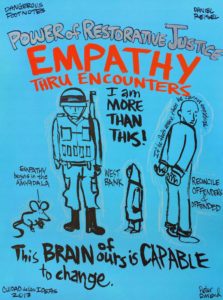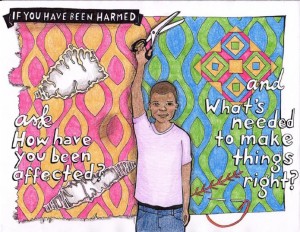restorative justice
Ubuntu
September 7, 2020Image credit: What is Ubuntu 01 (detail), Gretchen Andrew, 2018.
Fr Richard Rohr:
We think fear, anger, divine intimidation, threat, and punishment are going to lead people to love. Show me where that has worked. You cannot lead people to the highest level of motivation by teaching them the lowest.
Love is the only thing that transforms the human heart.
Restorative ♡.
Ubuntu: I am because we are.
Feminism and Restorative Justice
October 10, 2019The Inherent Feminism of Restorative Justice
Unpacking the legal model that puts victims first
By Anna Dorn
MEDIUM
Van Wormer explained that restorative justice has a “special relevance to marginalized communities, one of which is women.” Likewise, Walker told me that given pervasive gender bias in our culture, women are at greater risk of being harmed by the adversarial system. Women of color, she explained, are even more vulnerable than white women because the party facing more societal bias is at a greater disadvantage in the adversarial system. “If one party is bigger and stronger than the other, how can a fight between them ever be fair?”
Walker further suggested that restorative justice is inherently feminist. Rather than “paternalistic, autocratic and adversarial,” she wrote, “restorative justice is strength based and respects individuals [including women] as agents of their own lives.” Van Wormer likewise argued that the use of restorative justice is often consistent with feminism, which values empowering women and promoting our voices. Of special relevance to women’s victimization, van Wormer explained, are the following feminist values: reliance on the woman’s personal narrative; acceptance of a holistic, nondichotomized view of reality, including a unification of the personal and political; a focus on choice and options; an understanding of the gendered nature of societal power relations; and an emphasis on personal empowerment and dignity.
Walker further suggested that restorative justice is inherently feminist. Rather than “paternalistic, autocratic and adversarial,” she wrote, “restorative justice is strength based and respects individuals [including women] as agents of their own lives.”
Van Wormer outlined the four restorative justice models most relevant to women: victim-offender conferencing, family group conferencing, healing circles, and community reparations. Victim-offender conferencing brings together parties in which one person has injured another to resolve and, where possible, right the wrong. Unlike mediation, which implies a dispute to be negotiated, restorative conferencing recognizes its participants as victim and offender as opposed to disputants.
https://medium.com/s/all-rise/the-inherent-feminism-of-restorative-justice-71eca6fa9f42
Restorative justice.
June 12, 2018The aim of restorative justice is to return the person to a useful position in the community. Thus, there can be healing on both sides. Such justice is a mystery that only makes sense to the soul. It is a direct corollary of our “economy of grace” and yet the term restorative justice only entered our vocabulary in the last few decades. How can we deny that there is an evolution of consciousness?
What humanity really needs is an honest exposure of the truth and accountability for what has happened. Only then can human beings move ahead with dignity. Hurt needs to be spoken and heard. It does not just go away on its own.
As any good therapist will tell you, you cannot heal what you do not acknowledge. What you do not consciously acknowledge will remain in control from within, festering and destroying you and those around you. In the Gospel of Thomas, Jesus teaches, “If you bring forth that which is within you, it will save you. If you do not bring it forth, it will destroy you”.
Only mutual apology, healing, and forgiveness offer a sustainable future for humanity. Otherwise, we are controlled by the past, individually and corporately. We all need to apologize, and we all need to forgive or this human project will surely self-destruct. Otherwise, history devolves into taking sides, bitterness, holding grudges, and the violence that inevitably follows. As others have said, “Forgiveness is to let go of our hope for a different past.” Reality is what it is, and such acceptance leads to great freedom, as long as there is also both accountability and healing forgiveness.
-Richard Rohr, Center for Action
Asking better questions.
October 25, 2016Cultural Organizing:
This disproportionately harms low income Students of Color, exacerbates the large opportunity gaps that already exist, and fosters what has come to be known as the school-to-prison pipeline.
In response, we have seen rapid growth of the restorative justice movement, which offers a radically different approach. Restorative justice asks that we make a paradigm shift in the way we think about “crime” and “misbehavior.” As Dr. Carolyn Boyes-Watson at the Center for Restorative Justice at Suffolk University explains,
“Rather than privileging the law, professionals and the state, restorative resolutions engage those who are harmed, wrongdoers and their affected communities in search of solutions that promote repair, reconciliation and the rebuilding of relationships. Restorative justice seeks to build partnerships to reestablish mutual responsibility for constructive responses to wrongdoing within our communities. Restorative approaches seek a balanced approach to the needs of the victim, wrongdoer and community through processes that preserve the safety and dignity of all.”
Within this realm, practitioners have developed a wide range of “restorative practices” — such as victim-offender dialogues and peacemaking circles — often drawing on conflict resolution practices from indigenous societies around the world. But restorative justice cannot be reduced to a set of practices. It is a way of thinking about and approaching conflict. It requires a shift in how we relate to one another. It is about developing a restorative culture in our schools and communities.



